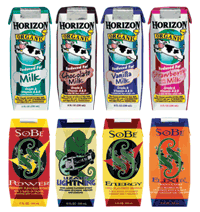
If the rollout of Tetra Pak’s Prisma aseptic carton is any indication, the future of beverage packaging rests firmly in the hands of America’s copackers.
A grown-up version of the Tetra Brik, Prisma is an octagonally shaped, grippable carton that is helping one-time niche products go mainstream. Three beverage companies are making a splash with products packaged in Prisma, and all of them are tapping copackers to pull off processing and packaging. The most recent is Boulder, Colo.’s Horizon Organic Dairy, which contracted with Elma, N.Y.-based Steuben Foods to package an 8-oz. single-serve version of its reduced fat organic milk.
Steuben already was packaging organic milk in gabletops for Horizon, so when the dairy added a Tetra Pak TBA-19 aseptic filling machine to handle Prisma, it was a logical extension for Steuben to copack single-serves for Horizon, according to Ken Schulberg, president of Steuben. “Low acid aseptic processing is very specialized technology,” he points out. “We’re seeing a few companies with expertise in that area installing these lines, and then the marketers come to them.”
The Prisma filler became Steuben’s tenth aseptic line when it went into operation seven months ago, adding a new dimension to production capacity that includes extended shelf life gabletops and pudding cups. The ability to expand available packaging options drove the decision to install the TBA-19 line, Schulberg says. “When we first saw this packaging in Europe and Japan, we felt it was one of the first Tetra Paks that was more than a functional product,” he explains. “It takes the aseptic carton out of the realm of a kid’s pack.”
SoBe Beverage Co. wanted to offer its customers a larger single-serve and that that need was filled by Savannah (Ga.) Manufacturing Co., which outputs an 11 oz./330 ml Prisma carton in three- and six-count Lizard Packs. The nutrient-enhanced drinks had been available in 20-oz. glass bottles, but Brand Manager Bill Meissner wanted a new look to appeal to a younger audience than SoBe’s core consumers: men in the 18-34 age bracket. The foil pull-tab makes Prisma chuggable, and aseptic filling extends shelf life and provides retailers with ambient-temperature merchandising options.
Two of North America’s first Prisma lines were installed in 1999 at California Natural Products, a Lathrup, Calif., copacker that purchased TBA-21 fillers that are set up for 330 ml cartons. The company runs 11 aseptic lines, including bulk fillers.
Power Dream, a sports nutrition drink from Imagine Foods Inc., San Carlos, Calif., was the first product to get the Prisma treatment at California Natural Products. It soon was followed by Nitro-Tech, a muscle-builder developed by a Canadian firm.
Golden, Colo.-based EAS Inc. recognized that a ready-to-drink version of powdered sports nutritional supplements was needed if the category was to break out of the specialty segment, and the low-acid nature of the drink would require aseptic packaging. EAS selected Prisma for AdvantEdge, then fueled a high-power marketing effort that featured celebrities such as Christie Brinkley and Cindy Crawford.
“We take all the risk in installing a filling line like this, which takes about four months to set up,” allows Rodney Tipton, vice president of California Natural Products. “On the other hand, the marketing company assumes the costs of promoting it and gaining shelf space.”
For more information:
Mike Guidry, Tetra Pak, 940-367-1520, mike.guidry@tetrapak.com